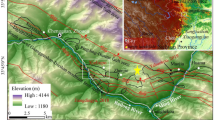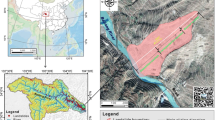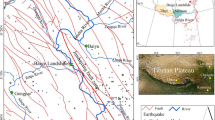Abstract
On September 14, 2019, a reactivated landslide with a volume of 1.3 × 107 m3 occurred in Changhe Town, Tongwei County, Gansu Province, China. As a result, a provincial highway, brickfield, and bridge were destroyed. Based on field investigation, interferometric synthetic aperture radar (InSAR) as well as unmanned aerial vehicle (UAV) photogrammetry, high-resolution remote sensing imagery, and digital elevation model, we addressed the surface displacement, travel distance, topographic changes, and causative factors of the Changhe landslide. The result shows the combination of ascending and descending orbit datasets can not only be used to monitor the landslide surface displacement but also to verify the deformation results. This landslide is a typical retrogressive landslide where large pre-failure deformation exists in the lower part of the landslide body. We detected the surface travel distance of the landslide and found spatial differences exist in the surface travel distance of the landslide. The deposit volume slightly exceeds erosion volume due to decompaction during the landslide. The frequency distribution of the basic topographic factors before and after the landslide is different, which indicates that the landslide event significantly changed the local topography and geomorphology. This study provides an insight into the spatiotemporal evolution of the landslide and has practical importance for early warning of landslides and risk mitigation.












Similar content being viewed by others
References
Bardi F, Frodella W, Ciampalini A, Bianchini S, Del Ventisette C, Gigli G, Fanti R, Moretti S, Basile G, Casagli N (2014) Integration between ground based and satellite SAR data in landslide mapping: the San Fratello case study. Geomorphology 223:45–60
Berardino P, Fornaro G, Lanari R, Sansosti E (2002) A new algorithm for surface deformation monitoring based on small baseline differential SAR interferograms. IEEE Trans Geosci Remote Sens 40(11):2375–2383
Burchfiel B, Zhang P, Wang Y, Zhang W, Song F, Deng Q, Molnar P, Royden L (1991) Geology of the Haiyuan Fault Zone, Ningxia-Hui Autonomous Region, China, and its relation to the evolution of the Northeastern Margin of the Tibetan Plateau. Tectonics 10:1091–1110. https://doi.org/10.1029/90TC02685
Chen R, Chang K, Angelier J, Chan Y, Deffontaines B, Lee C, Lin M (2006) Topographical changes revealed by high-resolution airborne LiDAR data: the 1999 Tsaoling landslide induced by the Chi-Chi earthquake. Eng Geol 88:160–172
Chen T, Zhang P, Liu J, Li C, Ren Z, Hudnut K (2014) Quantitative study of tectonic geomorphology along Haiyuan fault based on airborne LiDAR. Chin Sci Bull 59(20):2396–2409
Crawford M, Bryson L, Woolery E, Wang Z (2019) Long-term landslide monitoring using soil-water relationships and electrical data to estimate suction stress. Eng Geol 251:146–157
Crozier M (2009) Landslide geomorphology: an argument for recognition, with examples from New Zealand. Geomorphology 120:3–15
Cui Y, Zhou X, Guo C (2017) Experimental study on the moving characteristics of fine grains in wide grading unconsolidated soil under heavy rainfall. J Mt Sci 14(3):417–431
Cui S, Pei X, Wu H, Huang R (2018) Centrifuge model test of an irrigation-induced loess landslide in the Heifangtai loess platform, Northwest China. J Mt Sci 15(1):130–143
Dabski M, Zmarz A, Pabjanek P, Korczak-Abshire M, Karsznia I, Chwedorzewska K (2017) UAV-based detection and spatial analyses of periglacial landforms on Demay Point (King George Island, South Shetland Islands, Antarctica). Geomorphology 290:29–38
Dai K, Li Z, Tomas R, Liu G, Yu B, Wang X, Cheng H, Chen J, Stockamp J (2016) Monitoring activity at the Daguangbao mega-landslide (China) using Sentinel-1 TOPS time series interferometry. Remote Sens Environ 186:501–513
Deng Q, Zhu Z, Cui Z, Wang X (2000) Mass rock creep and landsliding on the Huangtupo slope in the reservoir area of the Three Gorges Project, Yangtze River, China. Eng Geol 58(1):67–83
Dong J, Zhang L, Li M, Yu Y, Liao M, Gong J, Luo H (2018) Measuring precursory movements of the recent Xinmo landslide in Mao County, China with Sentinel-1 and ALOS-2 PALSAR-2 datasets. Landslides 15(1):135–144
Dvigalo V, Melekestsev I (2009) The geological and geomorphic impact of catastrophic landslides in the Geyser Valley of Kamchatka: aerial photogrammetry. J Volcanol Seismol 3(5):314–325
Ferretti A, Prati C, Rocca F (2000) Nonlinear subsidence rate estimation using permanent scatterers in differential SAR interferometry. IEEE Trans Geosci Remote Sens 38(5):2202–2212
Ferretti A, Prati C, Rocca F (2001) Permanent scatterers in SAR interferometry. IEEE Trans Geosci Remote Sens 39(1):8–20
Ferretti A, Fumagalli A, Novali F, Prati C, Rocca F, Rucci A (2011) A new algorithm for processing interferometric data-stacks: SqueeSAR. IEEE Trans Geosci Remote Sens 49(9):3460–3470
Glade T, Crozier M (2010) Landslide geomorphology in a changing environment. Geomorphology 120:1–2. https://doi.org/10.1016/j.geomorph.2009.09.018
Guo J, Yi S, Yin Y, Cui Y, Qin M, Li T, Wang C (2020) The effect of topography on landslide kinematics: a case study of the Jichang town landslide in Guizhou, China. Landslides 17(4):959–973
He J, Qiu H, Qu F, Hu S, Yang D, Shen Y, Zhang Y, Sun H, Cao M (2021) Prediction of spatiotemporal stability and rainfall threshold of shallow landslides using the TRIGRS and Scoops3D models. Catena 197:104999. https://doi.org/10.1016/j.catena.2020.104999
Hsieh Y, Chan Y, Hu J (2016) Digital elevation model differencing and error estimation from multiple sources: a case study from the Meiyuan Shan Landslide in Taiwan. Remote Sens 8(3):199–219
Hu S, Qiu H, Wang X, Gao Y, Wang N, Wu J, Yang D, Cao M (2018) Acquiring high-resolution topography and performing spatial analysis of loess landslides by using low-cost UAVs. Landslides 15:593–612
Hu S, Qiu H, Wang N, Cui Y, Wang J, Wang X, Ma S, Yang D, Cao M (2020) The influence of loess cave development upon landslides and geomorphologic evolution: a case study from the northwest Loess Plateau, China. Geomorphology 359:107167. https://doi.org/10.1016/j.geomorph.2020.107167
Huang R (2009) Some catastrophic landslides since the twentieth century in the southwest of China. Landslides 6(1):69–81
Huang R, Xu Q (2008) Catastrophic landslide disasters in China[M]. Science Press, Beijing
Kovacs I, Czigany S, Dobre B, Fabian S, Sobucki M, Varga G, Bugya T (2019) A field survey-based method to characterise landslide development: a case study at the high bluff of the Danube, south-central Hungary. Landslides 16(8):1567–1581
Lanari R, Mora O, Manunta M, Mallorqui J, Berardino P, Sansosti E (2004) A small-baseline approach for investigating deformations on full-resolution differential SAR interferograms. IEEE Trans Geosci Remote Sens 42(7):1377–1386
Larsen I, Montgomery D (2012) Landslide erosion coupled to tectonics and river incision. Nat Geosci 5:468–473
Leng Y, Peng J, Wang Q, Meng Z, Huang W (2018) A fluidized landslide occurred in the Loess Plateau: a study on loess landslide in South Jingyang tableland. Eng Geol 236:129–136
Levy S, Jaboyedoff M, Locat J, Demers D (2012) Erosion and channel change as factors of landslides and valley formation in Champlain Sea Clays: the Chacoura River, Quebec, Canada. Geomorphology 145:12–18
Li Y, Jiao Q, Hu X, Li Z, Li B, Zhang J, Jiang W, Luo Y, Li Q, Ba R (2019) Detecting the slope movement after the 2018 Baige landslides based on ground-based and space-borne radar observations. Int J Appl Earth Obs Geoinf 84:101949. https://doi.org/10.1016/j.jag.2019.101949
Li M, Zhang L, Ding C, Li W, Xu Q (2020) Retrieval of historical surface displacements of the Baige landslide from time-series SAR observations for retrospective analysis of the collapse event. Remote Sens Environ 240:111695. https://doi.org/10.1016/j.rse.2020.111695
Liu P, Li Z, Hoey T, Kincal C, Zhang J, Zeng Q, Mullter J (2013) Using advanced InSAR time series techniques to monitor landslide movements in Badong of the Three Gorges region, China. Int J Appl Earth Obs Geoinf 21:253–264
Liu X, Zhao C, Zhang Q, Peng J, Zhu W, Lu Z (2018) Multi-temporal loess landslide inventory mapping with C-, X- and L-band SAR datasets—a case study of Heifangtai loess landslides. Remote Sens 10(11):1756–1784
Liu D, Cui Y, Guo J, Yu Z, Chan D, Lei M (2020) Investigating the effects of clay/sand content on depositional mechanisms of submarine debris flows through physical and numerical modeling. Landslides 17(8):1863–1880
Lucieer A, De Jong S, Turner D (2014) Mapping landslide displacements using Structure from Motion (SfM) and image correlation of multi-temporal UAV photography. Prog Phys Geogr 38(1):97–116
Ma S, Qiu H, Hu S, Yang D, Liu Z (2020) Characteristics and geomorphology change detection analysis of the Jiangdingya landslide on July 12, 2018, China. Landslides. https://doi.org/10.1007/s10346-020-01530-3
Meng Q, Li W, Raspini F, Xu Q, Peng Y, Ju Y, Zheng Y, Casagli N (2020) Time-series analysis of the evolution of large-scale loess landslides using InSAR and UAV photogrammetry techniques: a case study in Hongheyan, Gansu Province, Northwest China. Landslides. https://doi.org/10.1007/s10346-020-01490-8
Mora O, Mallorqui J, Broquetas A (2003) Linear and nonlinear terrain deformation maps from a reduced set of interferometric SAR images. IEEE Trans Geosci Remote Sens 41(10):2243–2253
Niethammer U, James M, Rothmund S, Travelletti J, Joswig M (2012) UAV-based remote sensing of the Super-Sauze landslide: evaluation and results. Eng Geol 128:2–11
Qiu H, Regmi A, Cui P, Cao M, Lee J, Zhu X (2016) Size distribution of loess slides in relation to local slope height within different slope morphologies. Catena 145:155–163
Qiu H, Cui P, Regmi A, Hu S, Wang X, Zhang Y, He Y (2017) Influence of topography and volume on mobility of loess slides within different slip surfaces. Catena 157:180–188
Qiu H, Cui P, Regmi A, Hu S, Wang X, Zhang Y (2018) The effects of slope length and slope gradient on the size distributions of loess slides: field observations and simulations. Geomorphology 300:69–76
Qiu H, Cui Y, Pei Y, Yang D, Hu S, Wang X, Ma S (2020) Temporal patterns of nonseismically triggered landslides in Shaanxi Province, China. Catena 187:104356. https://doi.org/10.1016/j.catena.2019.104356
Qu F, Qiu H, Sun H, Tang G (2020) Post-failure landslide change detection and analysis using optical satellite Sentinel-2 images. Landslides. https://doi.org/10.1007/s10346-020-01498-0
Rossi G, Tanteri L, Tofani V, Vannocci P, Moretti S, Casagli N (2018) Multitemporal UAV surveys for landslide mapping and characterization. Landslides 15(5):1045–1052
Shi X, Liao M, Li M, Zhang L, Cunningham C (2016) Wide-area landslide deformation mapping with multi-path ALOS PALSAR data stacks: a case study of Three Gorges Area, China. Remote Sens 8(2):136–150
Shi X, Zhang L, Zhou C, Li M, Liao M (2018) Retrieval of time series three-dimensional landslide surface displacements from multi-angular SAR observations. Landslides 15(5):1015–1027
Shi X, Xu Q, Zhang L, Zhao K, Dong J, Jiang H, Liao M (2019) Surface displacements of the Heifangtai terrace in Northwest China measured by X and C-band InSAR observations. Eng Geol 259:105181. https://doi.org/10.1016/j.enggeo.2019.105181
Squarzoni G, Bayer B, Franceschini S, Simoni A (2020) Pre- and post-failure dynamics of landslides in the Northern Apennines revealed by space-borne synthetic aperture radar interferometry (InSAR). Geomorphology 369:107353. https://doi.org/10.1016/j.geomorph.2020.107353
Sun P, Peng J, Chen L, Yin Y, Wu S (2009) Weak tensile characteristics of loess in China - an important reason for ground fissures. Eng Geol 108:153–159
Tang H, Li C, Hu X, Wang L, Criss R, Su A, Wu Y, Xiong C (2015) Deformation response of the Huangtupo landslide to rainfall and the changing levels of the Three Gorges Reservoir. Bull Eng Geol Environ 74(3):933–942
Tu X, Kwong A, Dai F, Tham L, Min H (2008) Field monitoring of rainfall infiltration in a loess slope and analysis of failure mechanism of rainfall-induced landslides. Eng Geol 105(1-2):134–150
Turner D, Lucieer A, De Jong S (2015) Time series analysis of landslide dynamics using an unmanned aerial vehicle (UAV). Remote Sens 7(2):1736–1757
Wang H, Sun P, Liu E, Li R (2020a) Dynamic properties of Tianshui saturated remolded loess: a laboratory study. Eng Geol 272:105570. https://doi.org/10.1016/j.enggeo.2020.105570
Wang H, Sun P, Zhang S, Han S, Li X, Wang T, Guo Q, Xin P (2020b) Rainfall-induced landslide in loess area, Northwest China: a case study of the Changhe landslide on September 14, 2019, in Gansu Province. Landslides 17(9):2145–2160
Yan Y, Cui Y, Tian Xin HS, Guo J, Wang Z, Yin S, Liao L (2020a) Seismic signal recognition and interpretation of the 2019 “7.23” Shuicheng landslide by seismogram stations. Landslides 17(5):1191–1206
Yan Y, Cui Y, Guo J, Hu S, Wang Z, Yin S (2020b) Landslide reconstruction using seismic signal characteristics and numerical simulations: case study of the 2017 “6.24” Xinmo landslide. Eng Geol 270:105582. https://doi.org/10.1016/j.enggeo.2020.105582
Yastika P, Shimizu N, Abidin H (2019) Monitoring of long-term land subsidence from 2003 to 2017 in coastal area of Semarang, Indonesia by SBAS DInSAR analyses using Envisat-ASAR, ALOS-PALSAR, and Sentinel-1A SAR data. Adv Space Res 63(5):1719–1736
Funding
This work was funded by the Second Tibetan Plateau Scientific Expedition and Research Program (STEP) (Grant No. 2019QZKK0902), International Science & Technology Cooperation Program of China (Grant No. 2018YFE0100100), National Natural Science Foundation of China (Grant No. 41771539), Strategic Priority Research Program of Chinese Academy of Sciences (Grant No. XDA20030301), International Partnership Program of Chinese Academy of Sciences (Grant No. 131551KYSB20160002), and China Postdoctoral Science Foundation (Grant No. 2019 M663792).
Author information
Authors and Affiliations
Corresponding author
Rights and permissions
About this article
Cite this article
Liu, Z., Qiu, H., Ma, S. et al. Surface displacement and topographic change analysis of the Changhe landslide on September 14, 2019, China. Landslides 18, 1471–1483 (2021). https://doi.org/10.1007/s10346-021-01626-4
Received:
Accepted:
Published:
Issue Date:
DOI: https://doi.org/10.1007/s10346-021-01626-4




